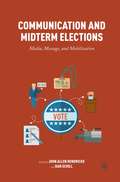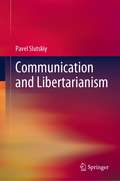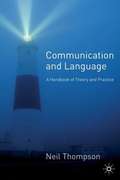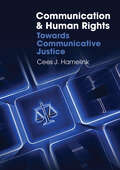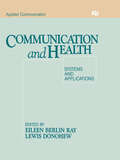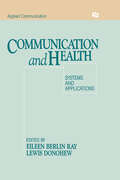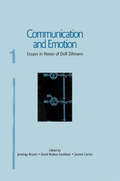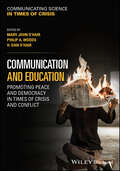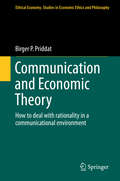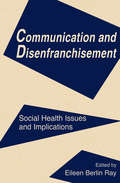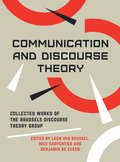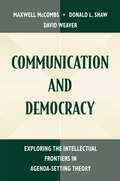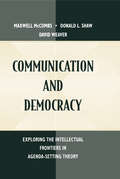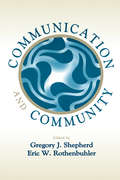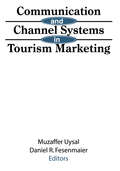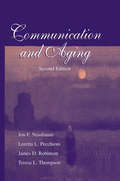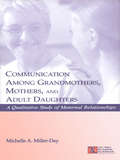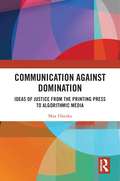- Table View
- List View
Communication and Midterm Elections: Media, Message, and Mobilization
by John Allen Hendricks Dan SchillThis book offers a comprehensive examination of midterm elections from the lens of communications and media coverage. Using a wide variety of methods, this contributed volume covers the differences, similarities, and challenges unique to midterm elections.
Communication and Libertarianism
by Pavel Slutskiy"This is an outstanding contribution to both libertarian political philosophy and communication theory. It is far and away the most comprehensive work on communication issues in libertarian theory ever published. The author has integrated successfully the libertarian insights of Mises, Rothbard, Block, Kinsella and others with the philosophy of language as developed by Austin, Searle and Grice. He has done so in a unique and unprecedented way. The book would appeal to students and scholars interested in libertarian theory and more generally, to philosophers and political scientists interested in high-level scholarship.” - David Gordon, libertarian philosopher and intellectual historian, Ludwig von Mises Institute.
Communication And Language: A Handbook Of Theory And Practice (PDF)
by Neil Thompson Jo CamplingCommunication and language are crucial parts of our everyday working lives. In this important textbook, Neil Thompson explores the complexities of the theory base and presents them in a clear and easily understandable form. However, this is not simply a book about theory. It also contains chapters on practice issues relating to face-to-face communications, communicating in writing and the management of communication systems. This is a helpful guide with much to offer all involved in working with people and their problems.
Communication and Human Rights: Towards Communicative Justice
by Cees J. HamelinkHuman rights and communication are deeply connected: human rights need communication to expose violations and to offer platforms for dialogue, while communication needs human rights to provide standards for free speech and confidentiality. Together, they confront the reality of today’s social and international order in which justice and understanding often seem unattainable.In this book, Cees J. Hamelink guides the reader through the historical evolution of communication and human rights. In this original framework, he discusses topics such as the right to communicate and freedom of expression, as well as major challenges posed by the environmental crisis and digital technologies. With authority, he passionately argues that ‘communicative justice’ is the ultimate goal of applying the international human rights regime to different forms of communication. This goal can only be achieved if we manage to move from the prevailing ‘thin’ liberal conception of human rights to a ‘thick’ cosmopolitan conception of them.Written by one of the world’s leading scholars in this area, this wide-ranging book will be of interest to students of media and communication, human rights scholars, as well as practitioners, activists and anyone interested in applying the notion of justice to the basis of human existence: communication.
Communication and Health: Systems and Applications (Routledge Communication Series)
by Eileen Berlin Ray Lewis DonohewThis volume examines this rapidly growing and changing field by applying a unified framework that integrates both interpersonal and mass communication investigations into theoretical and applied issues. Using a systems perspective as the organizational framework, relevant issues in the communication of health care, ranging from micro to macro levels, are discussed. The contributors recognize communication as a major factor affecting health today and therefore go beyond examinations of health communication as simply a dissemination of information regarding diseases, diagnoses, and treatments to show it as a much larger and more complex field with applications to all levels and forms of communication. Communication and Health has as its three main objecties: * providing a comprehensive, detailed, and up to-date picture of health communication * applying an integrated, logical structure to the field * making a clear, strong statement regarding the state of health communication and examining its future prospects The contributors address such issues as provider-patient communication, health care teams, health care organizations, public health campaigns, and health education, and then discuss the factors that affect the processing of health information. Also included are examinations of changes in communication use within interpersonal, small group, and organizational health care contexts as well as the use of mass media and other sources for public health campaigns and for raising public awareness of health issues on a day-to-day basis. Communication and Health fills a void in current literature on this field by serving as both a reference for professionals and researchers and as a textbook for advanced undergraduate and graduate level students in a multitude of courses.
Communication and Health: Systems and Applications (Routledge Communication Series)
by Eileen Berlin Ray Lewis DonohewThis volume examines this rapidly growing and changing field by applying a unified framework that integrates both interpersonal and mass communication investigations into theoretical and applied issues. Using a systems perspective as the organizational framework, relevant issues in the communication of health care, ranging from micro to macro levels, are discussed. The contributors recognize communication as a major factor affecting health today and therefore go beyond examinations of health communication as simply a dissemination of information regarding diseases, diagnoses, and treatments to show it as a much larger and more complex field with applications to all levels and forms of communication. Communication and Health has as its three main objecties: * providing a comprehensive, detailed, and up to-date picture of health communication * applying an integrated, logical structure to the field * making a clear, strong statement regarding the state of health communication and examining its future prospects The contributors address such issues as provider-patient communication, health care teams, health care organizations, public health campaigns, and health education, and then discuss the factors that affect the processing of health information. Also included are examinations of changes in communication use within interpersonal, small group, and organizational health care contexts as well as the use of mass media and other sources for public health campaigns and for raising public awareness of health issues on a day-to-day basis. Communication and Health fills a void in current literature on this field by serving as both a reference for professionals and researchers and as a textbook for advanced undergraduate and graduate level students in a multitude of courses.
Communication and Emotion: Essays in Honor of Dolf Zillmann (Routledge Communication Series)
by Jennings Bryant David Roskos-Ewoldsen Joanne CantorThis collection serves two important functions: it synthesizes theory and research in the vital and vibrant area of communication and emotion, and it highlights the scholarly work and contributions of Dolf Zillmann, the preeminent contributor to this area of inquiry.As one of the most productive and influential scholars in the annals of communication inquiry, Zillmann is well known for his contributions in the areas of communication, emotion, media effects, and aggression. Editors Jennings Bryant, David Roskos-Ewoldsen, and Joanne Cantor have collected groundbreaking essays from scholars active in the field, all of whom studied under or worked with Zillmann during his exemplary career. The contributions included here acknowledge the significance of Zillmann's work and identify many of the intellectual streams that contributed to his scholarship.Utilizing both psychology and communication perspectives, this volume covers the current literature in communication and emotion, with a focus on key theories, media effects, and entertainment theory. As a comprehensive synthesis of theory and research in communication and emotion, it will be of great interest to scholars in communication theory, cognitive and social psychology, and psychophysiology. With a concluding state-of-the-art chapter by Dolf Zillmann himself, this volume offers a thorough and distinctive examination of communication and emotion scholarship, and it will serve as an invaluable resource for current and future generations of scholars.
Communication and Emotion: Essays in Honor of Dolf Zillmann (Routledge Communication Series)
by Jennings Bryant David R. Roskos-Ewoldsen Joanne CantorThis collection serves two important functions: it synthesizes theory and research in the vital and vibrant area of communication and emotion, and it highlights the scholarly work and contributions of Dolf Zillmann, the preeminent contributor to this area of inquiry.As one of the most productive and influential scholars in the annals of communication inquiry, Zillmann is well known for his contributions in the areas of communication, emotion, media effects, and aggression. Editors Jennings Bryant, David Roskos-Ewoldsen, and Joanne Cantor have collected groundbreaking essays from scholars active in the field, all of whom studied under or worked with Zillmann during his exemplary career. The contributions included here acknowledge the significance of Zillmann's work and identify many of the intellectual streams that contributed to his scholarship.Utilizing both psychology and communication perspectives, this volume covers the current literature in communication and emotion, with a focus on key theories, media effects, and entertainment theory. As a comprehensive synthesis of theory and research in communication and emotion, it will be of great interest to scholars in communication theory, cognitive and social psychology, and psychophysiology. With a concluding state-of-the-art chapter by Dolf Zillmann himself, this volume offers a thorough and distinctive examination of communication and emotion scholarship, and it will serve as an invaluable resource for current and future generations of scholars.
Communication and Education: Promoting Peace and Democracy in Times of Crisis and Conflict (Communicating Science in Times of Crisis)
by Mary John O'HairA timely and insightful exploration of the vital relationships among effective communication, education, peace, and democracy Communication and Education: Promoting Peace and Democracy in Times of Crisis and Conflict explores the complexities of addressing divisive societal challenges, reducing conflicts, and building and sustaining peace and democracy around the world. Contributions by an international panel of experts provide evidence-based practices, findings from ongoing research projects, policy analyses, and cutting-edge theories, frameworks, and models for confronting global challenges to peace and democracy. Examining the crucial role of crisis communication and education on a global scale, this research-based compendium covers a broad range of key topics, such as democratizing education, promoting peace through complexity science, understanding how factionalism threatens democracy, encouraging citizen participation, and more. Throughout the text, the authors highlight the need for equity, compassion, critical thinking, and active engagement to create a sustainable future based on democratic values. Designed to enhance the knowledge base of crisis communication related to crises impacting education, peace, and democracy, Communication and Education: Explores different strategies and practices for fostering democracy in education, such as the IDEALS framework for creating positive school cultures Discusses emotional geographies in schools and their impact on democratic school climate and teacher burnout Emphasizes empathic communication and participatory skills among teachers Offers practical strategies and examples of harnessing technology for peace and democracy Provides real-world case studies illustrating the transformative power of education, music, diverse perspectives, and open communication channels Examines the ecological interdependence of effective communication, education, democracy and peace Part of the Wiley Blackwell Communicating Science in Times of Crisis series, Communication and Education: Promoting Peace and Democracy in Times of Crisis and Conflict is essential reading for communication and education scholars, researchers, students, practitioners, and community scientists.
Communication and Education: Promoting Peace and Democracy in Times of Crisis and Conflict (Communicating Science in Times of Crisis)
by Mary John O᾿Hair Philip A. Woods H. Dan O᾿HairA timely and insightful exploration of the vital relationships among effective communication, education, peace, and democracy Communication and Education: Promoting Peace and Democracy in Times of Crisis and Conflict explores the complexities of addressing divisive societal challenges, reducing conflicts, and building and sustaining peace and democracy around the world. Contributions by an international panel of experts provide evidence-based practices, findings from ongoing research projects, policy analyses, and cutting-edge theories, frameworks, and models for confronting global challenges to peace and democracy. Examining the crucial role of crisis communication and education on a global scale, this research-based compendium covers a broad range of key topics, such as democratizing education, promoting peace through complexity science, understanding how factionalism threatens democracy, encouraging citizen participation, and more. Throughout the text, the authors highlight the need for equity, compassion, critical thinking, and active engagement to create a sustainable future based on democratic values. Designed to enhance the knowledge base of crisis communication related to crises impacting education, peace, and democracy, Communication and Education: Explores different strategies and practices for fostering democracy in education, such as the IDEALS framework for creating positive school cultures Discusses emotional geographies in schools and their impact on democratic school climate and teacher burnout Emphasizes empathic communication and participatory skills among teachers Offers practical strategies and examples of harnessing technology for peace and democracy Provides real-world case studies illustrating the transformative power of education, music, diverse perspectives, and open communication channels Examines the ecological interdependence of effective communication, education, democracy and peace Part of the Wiley Blackwell Communicating Science in Times of Crisis series, Communication and Education: Promoting Peace and Democracy in Times of Crisis and Conflict is essential reading for communication and education scholars, researchers, students, practitioners, and community scientists.
Communication and Economic Theory: How to deal with rationality in a communicational environment (Ethical Economy #47)
by Birger P. PriddatThis book analyzes the different topics which highlight the relevance of communication within markets. In using and reformulating concepts of Arrow, Commons, Williamson, North, Becker and others, the author shows the hidden implications of these authors for a new approach in economics: communication matters. Markets are systems of allocation, which are governed by communication networks. In Economics, so far, communication processes play a minor role. During the last century, there was a tendency of using ‘communication’ as a tool for reintroducing the diversity of rational actions. Yet, communication is a governance-structure of its own, which cannot be used as a tool, since communication is disturbing the expectations of the economics actors and changing the actor’s preferences as well as their belief-systems. By using examples such as Kenneth Arrow’s economics actor theory and Douglas North’s emphasis on communication being a process of building ‘shared mental models’, this book argues that if communication matters, we have to reinterpret the basics of economic methodology and integrate network-processing and discourse theories.
Communication and Disenfranchisement: Social Health Issues and Implications (Routledge Communication Series)
by Eileen Berlin RayThis volume and its companion case studies book deal with some of the people, groups, and classes who are living a disenfranchised existence in the United States. Whether through birth, life events, or unfortunate circumstances, they are denied full privileges, rights, and power within the existing societal structure. Centered around societal health problems as they relate to socioeconomic status, family, abuse, and health concerns, these volumes examine salient issues from several theoretical frameworks, including feminist theory and the social construction of reality. Communication and Disenfranchisement provides theory-based essays on topics such as the homeless, adult survivors of sexual assault, battered women, persons with disabilities, impoverished women, the indigent living in the inner city, persons with HIV/AIDS, the terminally ill, and the elderly. Case Studies in Communication and Disenfranchisement provides parallel case studies, applying the issues and concepts discussed in the essays. Used together, these books provide theoretically-based applications of social health issues within a communication framework. Traditionally, health communication research has emphasized the communication-physical health relationship. Inadvertently, this primary focus has restricted what information has been included under the domain of health communication. These books expand that domain by examining how the communication-disenfranchisement relationship is accomplished, managed, and overcome, and by recognizing the significance of the pragmatic and theoretic implications of this inquiry.
Communication and Disenfranchisement: Social Health Issues and Implications (Routledge Communication Series)
by Eileen Berlin RayThis volume and its companion case studies book deal with some of the people, groups, and classes who are living a disenfranchised existence in the United States. Whether through birth, life events, or unfortunate circumstances, they are denied full privileges, rights, and power within the existing societal structure. Centered around societal health problems as they relate to socioeconomic status, family, abuse, and health concerns, these volumes examine salient issues from several theoretical frameworks, including feminist theory and the social construction of reality. Communication and Disenfranchisement provides theory-based essays on topics such as the homeless, adult survivors of sexual assault, battered women, persons with disabilities, impoverished women, the indigent living in the inner city, persons with HIV/AIDS, the terminally ill, and the elderly. Case Studies in Communication and Disenfranchisement provides parallel case studies, applying the issues and concepts discussed in the essays. Used together, these books provide theoretically-based applications of social health issues within a communication framework. Traditionally, health communication research has emphasized the communication-physical health relationship. Inadvertently, this primary focus has restricted what information has been included under the domain of health communication. These books expand that domain by examining how the communication-disenfranchisement relationship is accomplished, managed, and overcome, and by recognizing the significance of the pragmatic and theoretic implications of this inquiry.
Communication and Discourse Theory: Collected Works of the Brussels Discourse Theory Group
by Leen Van Brussel Nico Carpentier Benjamin De CleenDrawing on a variety of case studies, ranging from the politics of reality TV to the representation of populism, Communication and Discourse Theory highlights both the radical contingent nature and the hegemonic workings of media and communication practices.
Communication and Democracy: Exploring the intellectual Frontiers in Agenda-setting theory (Routledge Communication Series)
by Maxwell E. McCombs Donald L. Shaw David H. WeaverExciting intellectual frontiers are open for exploration as agenda-setting theory moves beyond its 25th anniversary. This volume offers an intriguing set of maps to guide this exploration over the near future. It is intended for those who are already reasonably well read in the research literature that has accumulated since the publication of McCombs and Shaw's original 1972 Public Opinion Quarterly article. This piece of literature documented the influence of the news media agenda on the public agenda in a wide variety of geographic and social settings, elaborated the characteristics of audiences and media that enhance or diminish those agenda-setting effects, and cataloged those exogenous factors explaining who sets the media's agenda. In the current volume, a provocative set of maps for explicating new levels of agenda-setting theory have been sketched by a new generation of young scholars, launching an enterprise that has significant implications for theoretical research and for the day-to-day role of mass communication in democratic societies. At the first level of agenda setting are agendas of objects--the traditional domain of agenda setting research--represented by an accumulation of hundreds of studies over the past quarter century. At the second level of agenda setting are agendas of attributes--one of the new theoretical frontiers whose aspects are discussed in detail in the opening chapters. Other chapters offer maps of yet other theoretical frontiers, including political advertising agendas and their impact on behavior, the framing of various agendas in the mass media and the differential impact of print and TV, the theoretical role of individual differences in the agenda-setting influence of the news media on the public agenda, methodological advances for determining cause and effect roles in agenda-setting, and the application of agenda-setting theory to historical analysis. This volume is an invitation to others to become active members of the invisible college of agenda-setting scholarship. As such, the goals of this book are threefold: * to introduce a broad set of ideas about agenda-setting; * to enrich the exploration of these ideas by enhancing scholarly dialogue among the members of this invisible college; and * to enhance the discussion of agenda-setting research in seminars and research groups around the world. Agenda-setting has remained a vital and productive area of communication research over a quarter century because it has continued to introduce new research questions into the marketplace of ideas and to integrate this work with other theoretical concepts and perspectives about journalism and mass communication. Understanding the dynamics of agenda- setting is central to understanding the dynamics of contemporary democracy. This book's set of theoretical essays, grounded in the accumulated literature of agenda- setting theory and in the creative insights of young scholars, will help lead the way toward that understanding.
Communication and Democracy: Exploring the intellectual Frontiers in Agenda-setting theory (Routledge Communication Series)
by Maxwell McCombs Donald L. Shaw David WeaverExciting intellectual frontiers are open for exploration as agenda-setting theory moves beyond its 25th anniversary. This volume offers an intriguing set of maps to guide this exploration over the near future. It is intended for those who are already reasonably well read in the research literature that has accumulated since the publication of McCombs and Shaw's original 1972 Public Opinion Quarterly article. This piece of literature documented the influence of the news media agenda on the public agenda in a wide variety of geographic and social settings, elaborated the characteristics of audiences and media that enhance or diminish those agenda-setting effects, and cataloged those exogenous factors explaining who sets the media's agenda. In the current volume, a provocative set of maps for explicating new levels of agenda-setting theory have been sketched by a new generation of young scholars, launching an enterprise that has significant implications for theoretical research and for the day-to-day role of mass communication in democratic societies. At the first level of agenda setting are agendas of objects--the traditional domain of agenda setting research--represented by an accumulation of hundreds of studies over the past quarter century. At the second level of agenda setting are agendas of attributes--one of the new theoretical frontiers whose aspects are discussed in detail in the opening chapters. Other chapters offer maps of yet other theoretical frontiers, including political advertising agendas and their impact on behavior, the framing of various agendas in the mass media and the differential impact of print and TV, the theoretical role of individual differences in the agenda-setting influence of the news media on the public agenda, methodological advances for determining cause and effect roles in agenda-setting, and the application of agenda-setting theory to historical analysis. This volume is an invitation to others to become active members of the invisible college of agenda-setting scholarship. As such, the goals of this book are threefold: * to introduce a broad set of ideas about agenda-setting; * to enrich the exploration of these ideas by enhancing scholarly dialogue among the members of this invisible college; and * to enhance the discussion of agenda-setting research in seminars and research groups around the world. Agenda-setting has remained a vital and productive area of communication research over a quarter century because it has continued to introduce new research questions into the marketplace of ideas and to integrate this work with other theoretical concepts and perspectives about journalism and mass communication. Understanding the dynamics of agenda- setting is central to understanding the dynamics of contemporary democracy. This book's set of theoretical essays, grounded in the accumulated literature of agenda- setting theory and in the creative insights of young scholars, will help lead the way toward that understanding.
Communication and Community (Routledge Communication Series)
by Gregory J. Shepherd Eric W. RothenbuhlerThis distinctive volume combines synthetic theoretical essays and reports of original research to address the interrelations of communication and community in a wide variety of settings. Chapters address interpersonal conversation and communal relationships; journalism organizations and political reporting; media use and community participation; communication styles and alternative organizations; and computer networks and community building; among other topics. The contents offer synthetic literature reviews, philosophical essays, reports of original research, theory development, and criticism. While varying in theoretical perspective and research focus, each of the chapters also provides its own approach to the practice of communication and community. In this way, the book provides a recurrent thematic emphasis on the pragmatic consequences of theory and research for the activities of communication and living together in communities. Taken as a whole, this collection illustrates that communication and community cannot be adequately analyzed in any context without considering other contexts, other levels of analysis, and other media and modes of communication. As such, it provides important insights for scholars, students, educators, and researchers concerned with communication across the full range of contexts, media, and modes.
Communication and Community (Routledge Communication Series)
by Gregory J. Shepherd Eric W. RothenbuhlerThis distinctive volume combines synthetic theoretical essays and reports of original research to address the interrelations of communication and community in a wide variety of settings. Chapters address interpersonal conversation and communal relationships; journalism organizations and political reporting; media use and community participation; communication styles and alternative organizations; and computer networks and community building; among other topics. The contents offer synthetic literature reviews, philosophical essays, reports of original research, theory development, and criticism. While varying in theoretical perspective and research focus, each of the chapters also provides its own approach to the practice of communication and community. In this way, the book provides a recurrent thematic emphasis on the pragmatic consequences of theory and research for the activities of communication and living together in communities. Taken as a whole, this collection illustrates that communication and community cannot be adequately analyzed in any context without considering other contexts, other levels of analysis, and other media and modes of communication. As such, it provides important insights for scholars, students, educators, and researchers concerned with communication across the full range of contexts, media, and modes.
Communication and Channel Systems in Tourism Marketing
by Muzaffer Uysal Daniel FesenmaierWhat sources of information do tourists consult when choosing a travel destination? How can communication channels be used to reach the tourist market for a specific region? This resource provides new insight into these important questions and more on developing tourism marketing strategies using the key factors of communication and channel systems. Communication and Channel Systems in Tourism Marketing features both conceptual and applied research which provides an excellent base for tourism marketers and destination planners to evaluate and improve their overall tourism marketing programs. Tourism and hospitality scholars discuss communication distribution channels, media selection, information needs and sources, importance of travel brochures and slogans, brochure design, and the effectiveness of communication messages in tourism marketing. The advantages and disadvantages of a wide variety of communication channels are explored including word-of-mouth, brochures/pamphlets, travel agents, magazines, radio, television, and slogans. Some of the topics covered in this book that demonstrate the use of communication and channel systems in tourism marketing are: building repeat visitor relationships image formation distribution channels communication messages and their effectiveness design of destination- and attraction-specific brochures communicating unique selling propositions in slogans This groundbreaking book presents original, empirical research that incorporates communications and channels systems as integral components of tourism marketing. The diversity and originality of these tourism research cases will be helpful to destination promoters, tourism decisionmakers, and tourism planners worldwide. Communication and Channel Systems in Tourism Marketing is also a valuable supplementary text for students in courses on leisure, recreation, hospitality, tourism, and marketing.
Communication and Channel Systems in Tourism Marketing
by Muzaffer Uysal Daniel FesenmaierWhat sources of information do tourists consult when choosing a travel destination? How can communication channels be used to reach the tourist market for a specific region? This resource provides new insight into these important questions and more on developing tourism marketing strategies using the key factors of communication and channel systems. Communication and Channel Systems in Tourism Marketing features both conceptual and applied research which provides an excellent base for tourism marketers and destination planners to evaluate and improve their overall tourism marketing programs. Tourism and hospitality scholars discuss communication distribution channels, media selection, information needs and sources, importance of travel brochures and slogans, brochure design, and the effectiveness of communication messages in tourism marketing. The advantages and disadvantages of a wide variety of communication channels are explored including word-of-mouth, brochures/pamphlets, travel agents, magazines, radio, television, and slogans. Some of the topics covered in this book that demonstrate the use of communication and channel systems in tourism marketing are: building repeat visitor relationships image formation distribution channels communication messages and their effectiveness design of destination- and attraction-specific brochures communicating unique selling propositions in slogans This groundbreaking book presents original, empirical research that incorporates communications and channels systems as integral components of tourism marketing. The diversity and originality of these tourism research cases will be helpful to destination promoters, tourism decisionmakers, and tourism planners worldwide. Communication and Channel Systems in Tourism Marketing is also a valuable supplementary text for students in courses on leisure, recreation, hospitality, tourism, and marketing.
Communication and Aging (Routledge Communication Series)
by Jon F. Nussbaum Loretta L. Pecchioni James D. Robinson Teresa L. ThompsonThis text employs a communication perspective to examine the aging process and the ability of individuals to adapt successfully to aging. It continues the groundbreaking work of the first edition, emphasizing a life-span approach toward understanding the social interaction that occurs during later life. The edition provides a comprehensive update on the existing and emerging research within communication and aging studies and considers such topics as notions of successful aging, positive and negative stereotypes toward older adults, and health communication issues. It raises awareness of the barriers facing elderly people in conversation and the importance such conversations have in elderly people's lives. The impact of nonrelational processes, such as hearing loss, are considered as they impact relationships with others and affect the ability to age successfully. The book is organized into 14 chapters. Each chapter is written so that the reader is presented with an exhaustive review of the pertinent and recent literature from the social sciences. As in the first edition, when the literature is empirically based, the communicative ramifications are then discussed. Readers of this volume will gain greater understanding of the importance of their communicative relationships and how significant they remain across the life span. Developed for students in communication, psychology, nursing, social gerontology, sociology, and related areas, Communication and Aging provides important insights on communication to all who are affected by the aging process.
Communication and Aging (Routledge Communication Series)
by Jon F. Nussbaum Loretta L. Pecchioni James D. Robinson Teresa L. ThompsonThis text employs a communication perspective to examine the aging process and the ability of individuals to adapt successfully to aging. It continues the groundbreaking work of the first edition, emphasizing a life-span approach toward understanding the social interaction that occurs during later life. The edition provides a comprehensive update on the existing and emerging research within communication and aging studies and considers such topics as notions of successful aging, positive and negative stereotypes toward older adults, and health communication issues. It raises awareness of the barriers facing elderly people in conversation and the importance such conversations have in elderly people's lives. The impact of nonrelational processes, such as hearing loss, are considered as they impact relationships with others and affect the ability to age successfully. The book is organized into 14 chapters. Each chapter is written so that the reader is presented with an exhaustive review of the pertinent and recent literature from the social sciences. As in the first edition, when the literature is empirically based, the communicative ramifications are then discussed. Readers of this volume will gain greater understanding of the importance of their communicative relationships and how significant they remain across the life span. Developed for students in communication, psychology, nursing, social gerontology, sociology, and related areas, Communication and Aging provides important insights on communication to all who are affected by the aging process.
Communication Among Grandmothers, Mothers, and Adult Daughters: A Qualitative Study of Maternal Relationships (LEA's Series on Personal Relationships)
by Michelle A. Miller-DayThis volume examines communication processes within the grandmother-mother-daughter relationship, emphasizing an intergenerational perspective. Using observations of and extensive interviews with six sets of middle-income, Caucasian female family members, this book offers a heuristic account of intergenerational mother-daughter relational communication.Author Michelle Miller-Day integrates and juxtaposes alternative experiences of social interaction, situating readers in the world of grandmothers, mothers, adult daughters, and granddaughters as they experience, describe, and analyze their family communication. Miller-Day incorporates aged mothers and younger mid-life mothers and their adult daughters into the research to illustrate how this type of maternal relationship is experienced at different points in a woman's life. With the inclusion of three generations of women, Miller-Day offers multigenerational perspectives on family, and examines them for patterns of maternal interaction, providing symbolic links across generational boundaries.Communication Among Grandmothers, Mothers, and Adult Daughters enables readers to understand more completely the richly textured nature of maternal relationships. It will be an invaluable resource for scholars and researchers in the areas of communication and relationships, including family communication, intergenerational communication, women's studies, family studies, interpersonal communication, and relationships, as well as social workers, psychologists, and counselors, who strive to understand family communication processes and their dynamics across generational lines.
Communication Against Domination: Ideas of Justice from the Printing Press to Algorithmic Media
by Max HänskaThis book tackles the philosophical challenge of bridging the gap between empirical research into communication and information technology, and normative questions of justice and how we ought to communicate with each other. It brings the question of what justice demands of communication to the center of social science research. Max Hänska undertakes expansive philosophical analysis to locate the proper place of normativity in social science research, a looming subject in light of the sweeping roles of information technologies in our social world today. The book’s first section examines metatheoretical issues to provide a framework for normative analysis, while the second applies this framework to three technological epochs: broadcast communication, the Internet and networked communications, and the increasing integration of artificial intelligence and machine learning technologies into our communication systems. Hänska goes beyond the prevailing frameworks in the field by exploring how we answer normative questions and how our answer can change depending on our social context and the affordances of prevailing communications technologies. This book provides an essential guide for scholars as well as graduate and advanced undergraduate students of research and theory in communication, philosophy, political science, and the social sciences.
Communication Against Domination: Ideas of Justice from the Printing Press to Algorithmic Media
by Max HänskaThis book tackles the philosophical challenge of bridging the gap between empirical research into communication and information technology, and normative questions of justice and how we ought to communicate with each other. It brings the question of what justice demands of communication to the center of social science research. Max Hänska undertakes expansive philosophical analysis to locate the proper place of normativity in social science research, a looming subject in light of the sweeping roles of information technologies in our social world today. The book’s first section examines metatheoretical issues to provide a framework for normative analysis, while the second applies this framework to three technological epochs: broadcast communication, the Internet and networked communications, and the increasing integration of artificial intelligence and machine learning technologies into our communication systems. Hänska goes beyond the prevailing frameworks in the field by exploring how we answer normative questions and how our answer can change depending on our social context and the affordances of prevailing communications technologies. This book provides an essential guide for scholars as well as graduate and advanced undergraduate students of research and theory in communication, philosophy, political science, and the social sciences.
